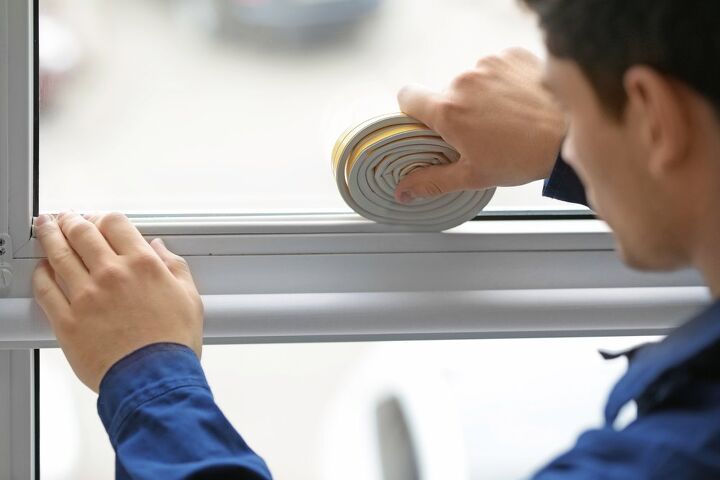How To Insulate Windows For Winter

Having a drafty home, especially during winter, is not something that anyone wants. It’s cold, and you lose too much heat, which drives your heating bill up. So, what can you do if you are experiencing drafts coming through?
You need to insulate your windows. First, clean the sashes and thoroughly dry the area. Check for drafts on all sides of your windows. Next, measure your windows, and install storm windows over your existing ones. You can use bubble wrap, weather stripping, or re-caulk your windows for cheaper alternatives.
Below, we will present you with some options for insulating your windows. This way, it doesn’t cost and arm and a leg, you can keep your heating bill down, and you home will stay nice a cozy!
What Should You Do Before Installing The Insulation?
If you haven’t already done some preparation work, you shouldn’t begin the actual process of insulating a window.
Start by thoroughly cleaning the area around the glass, including the horizontal sills, the door frames, and the glass casing.
Use a dry microfiber cloth to get rid of dirt and other debris. If you come across any filth or sticky materials that are difficult to remove, wet the microfiber cloth or use a mild home cleanser.
How Do You Insulate Your Windows For Winter?
Insulating your windows is super simple! You don’t need to hire a professional for this, as it’s an easy DIY project even for beginners.
Step 1: Check For Air Leaks In The Window
Now is the moment to check the area around the window for air leaks. Hold your hand close to various parts of the window frame on a windy or chilly day.
Examine the window frame from the inside and the outside if you detect a draft or moving air. You can find the leak’s most likely source if you see any cracks or loosened construction materials.
Something else you can try is holding a lit candle close to where you think the leak may be coming from if you’re not sure you’re feeling any drafts.
Turn off any fans and hold the flame close to the window. If you see the flame move, this most likely means there is a draft blowing through.
Step 2: Examine Inside And Outside The Windows
Examine the caulk both inside and outside the window, where the glass meets the frame. You should prepare to add more caulk to the window if the existing caulk is gone, peeling away, or if it is curled.
The interior caulk of the window typically doesn’t require replacement as frequently due to the lack of weather exposure, like the outside caulk. However, it might occasionally need to be replaced around the windows, trim, or sill.
Step 3: Measure Windows
You must precisely determine the dimensions of the window’s rough opening if you want to replace the window or add any insulation.
Take a measurement from the inside border of the side jambs and the sill for both the horizontal and vertical measurements. A total of three measurements should be made in each quadrant.
Step 4: Put Storm Windows Over your Existing Windows
Although they require an investment, storm windows are far less expensive than brand-new windows. The average cost of storm windows with such a low-E glass coating is between $60 to $200 per window, which is much less than the price of installing new windows.
They are also simple for homeowners to place on their own, without the aid of a qualified remodeler, since they slide over the outside of the window.
Step 5: Re-Caulk Your Windows
Re-caulking will make all the difference once you get everything else in place! You’ll want to check for any gaps. Even if you come across a questionable spot, it’s best to caulk it rather than let it sit.
What Are Some Cheap Alternatives To Caulking Your Windows?
If you aren’t sure how to caulk your windows but would instead do this project yourself than pay them for a professional, we understand! Below are some instructions for you to follow.
Apply Bubble Wrap
A less expensive way to do the plastic wrap thing is to tape plastic bubble wrap across your windows if you don’t care too much about appearances. Use heavy-duty packing tape to form a strong seal and lay the ends flat.
Check Into Removable Magnetic Insulation Kits For Windows
Detachable magnetized window insulation is the best answer if you wish to periodically open your windows in the winter.
Magnets keep the insulating vinyl in place instead of tape, allowing you to install the insulation only on cold days and leave it off the rest of the time.
You simply paint the trim in magnetic paint. This will help the insulated cloth hold to your window. Simply pull it off when you don’t need it in place!
Seal Your Windows Using Foam Tape
Although caulking windows won’t work everywhere, this will help you find many air infiltration points. Your windows can’t really be sealed shut, after all! Use double-sided foam tape for a little extra defense.
The top and bottom around contemporary vinyl window frames sashes are now weather-sealed with fiber. (Well, most of them are.) However, after time, it contracts and lets drafts in.
The solution for this is to apply a double-sided foam weather stripping sheet across the top and bottom.
Fix The Broken Glass
Your capacity to keep chilly drafts from entering your home will be impacted by glass shards in your windows. Window repairs typically cost between $40 and $100 to patch a fractured pane and between $200 and $500 to replace window glass.
In any season, it is worthwhile to invest in new glass because it also offers an aesthetic advantage. We strongly advise you to hire a professional to do this as it can be very dangerous. However, you can do this on your own, too; just be very careful!
Apply Plastic Film
This advice is great because it’s so affordable! Self-adhesive plastic film or shrink-wrapping the film to the window using a hairdryer are both inexpensive ways to block the entry of cold air through the glass.
Again, replacing the windows is the best long-term option, mainly because they are probably also letting heat in throughout the summer. Nevertheless, this serves as a good stopgap until you can get a new set.
Buy Some Thermal Curtains
Hanging a set of thermally-insulated drapes is one more technique to insulate windows for the winter. They are particularly resistant to stray drafts and chills because they have a tiny piece of foam sandwiched between two layers of cloth.
The panels for these drapes may be purchased for less than $20 each. On the other hand, thickly woven, heavy curtains can produce a comparable result. Anything that traps the cold is generally a good idea and works just as well as a sweater!
Block Gaps With Weather Stripping
Weatherstripping works like caulk, blocking gaps between the glass pane and the frame where the cold air could seep indoors.
Weatherstripping is a less permanent solution than caulk, and it doesn’t blend in as easily with your window. However, it is affordable and easy to install, so it’s a viable option for insulating a window.
Inspect your weather stripping for signs of damage or loose areas. If the stripping around your windows needs replacing, you’ll first have to remove the old stuff before applying the new.
Pressure-sensitive foam weather stripping is the easiest to apply, and you can add it to areas of the window that do not create friction. Otherwise, the foam could pull away as the window slides across it.
Alternatively, you can use the foam wherever you don’t intend to raise your window for a few months, even during winter. You can place this on any side.
Here is the best way to install the weather stripping:
- Clean the sash. Clean the area of the sash in which the weather strip will go with water and gentle dish soap.
- Dry the area. After using a fresh cloth to dry the area, wait several minutes for any water that remains to evaporate.
- Apply the stripping. To fit the length of the space where you will attach it, cut the weather stripping to that length. The adhesive layer should be pressed onto the foam after removing the protective backing.
Does Putting Plastic Over Windows Help Insulate?
Covering the window with plastic shrink film may reduce drafts and make your home feel a lot cozier. Although it will help, plastic shrink film doesn’t nearly have the same insulating qualities as new windows or add insulation to the window jamb. However, it’s a cheap way to keep your house cozy if you’re trying to do this in a pinch.

Heather is a passionate writer who loves anything DIY. Growing up, she learned everything from home repairs to design, and wants to share her tips with you. When she's not writing, she's usually hiking or searching for her next DIY project.
More by Heather Robbins













![10 Best Electric Pressure Washers – [2022 Reviews & Guide]](https://cdn-fastly.upgradedhome.com/media/2023/07/31/9070600/10-best-electric-pressure-washers-2022-reviews-guide.jpg?size=350x220)













